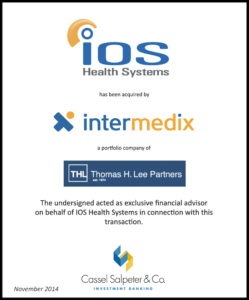Scaling business development to drive growth
To view the original article, click here.
By James S. Cassel
Special to the Miami Herald
November 16, 2014
Sustainable business development is a common challenge for growing businesses, particularly those in the lower and middle markets. Several hallmarks of successful business development and growth strategies have distinguished themselves in my years of experience at Cassel Salpeter. Those hallmarks include clearly defined business development responsibilities and roles; agile, relevant technological solutions (customer relationship management); and consistent sales staff training and benchmarking, among others.
The onus of business development tends to fall to the owners/founders of smaller businesses until the companies have reached a critical threshold. That threshold isn’t clearly delineated, but it could be summarily understood as the point at which the operation of the business and the development of new business are both demanding and granular enough that the roles warrant a “conscious uncoupling.” Whether the responsibility of business development is distributed to a sales team acting under a supervisor, or to a single (or pair) of executives, largely depends on your business model, potential customer base, market size and internal dynamics.
Making matters more complicated, it is often difficult for founders to give up the business development role that they have personally handled for a long time and empower the new people. When the decision is made to delegate business development responsibilities, identifying the right personnel for the role and for your company is mission critical. While there are a plethora of potential sources to utilize when searching for strong talent, many businesses take one of several routes: relying on a current team member who can be cultivated into the role, recruiting from a competitor, or recruiting from an organization that meticulously trains its sales people. If you choose the latter, be mindful that your candidates’ organizational training is compatible with your business, goals, scope and scale.
Selecting who steers your ship is only the beginning of a robust business development program. The value of a lead will be determined by your business model, but whether you can get leads for a penny or a pound, how will your team begin qualifying, managing and screening leads? As far as customer relationship management solutions, SalesForce is a multi-industry favorite, but there may be value in a proprietary or modified CRM solution. It’s important to keep in mind that while these technologies and platforms seem brimming with bells and whistles, you’re buying a product off the shelf, and it may not fit as well as a tailored CRM solution might.
Whether you recruit or promote from within, providing ongoing mentoring, training and development opportunities will greatly enhance a successful business development program. You may decide to create an internal training process unique to the needs of your organization, or you may send your sales team to conferences like DreamForce, the SalesForce annual conference responsible for virtually shutting down the streets of San Francisco this past October with an attendee count that pushed above 130,000. It is just one of the many programs available today.
Recruiting, hiring and training your sales team is no small task for any busy, buzzing organization, but it’s crucial to see these necessary steps as an opportunity to refine your own lead management and business cultivation processes so that your newly minted sales force isn’t inheriting a broken or outdated system. Revisit your client or customer identification methods and hard-bake best practices for accessing them into your training processes. Consider your business model — if you’re selling products as opposed to selling services, your sales strategy is likely taking a different tack.
If you’re selling products, remember that distribution does not necessarily equal sales. For example, if you own a liquor company, getting your product distributed by Southern Wine & Spirits might not necessarily be huge for sales. You will still have to close the sales loop through promotions and activations, branding and awareness campaigns, otherwise your bottles are going to gather dust and eventually the person who manages inventory is going to notice that those bottles aren’t moving and may decide to replace your product with one that’s more likely to fly off the shelf.
Finally, and most importantly, stay focused on your business objectives. If you are scaling your distribution to include the likes of the Walmarts or Saks Fifth Avenues of the world, it should be because placement in those retailers will drive sales. Obtaining those distribution routes for vanity will only disappoint you and the retailers with whom you’re working.
These hallmarks of good business development are by no means exhaustive or all-encompassing, and seasoned veterans will tell you scaling business development presents unique obstacles and opportunities for every business. There are no purple pills or cookie-cutter approaches. The right solution for you depends on your business model, your industry and your organization. By taking the time to consult qualified professionals and develop the right plans and processes, you can significantly increase your chances of achieving your business goals.
James Cassel is co-founder and chairman of Cassel Salpeter & Co., an investment-banking firm with headquarters in Miami that works with middle-market companies. www.casselsalpeter.com or jcassel@casselsalpeter.com.








